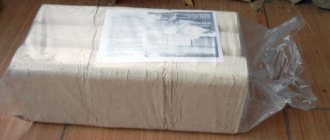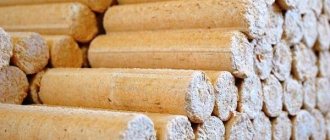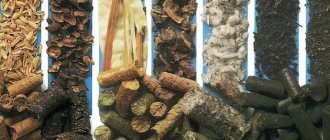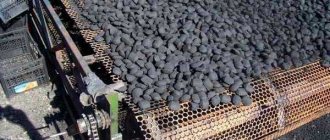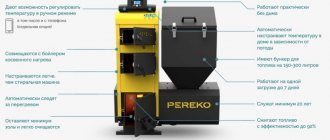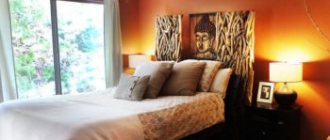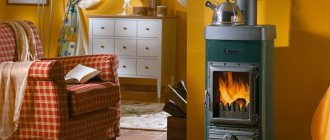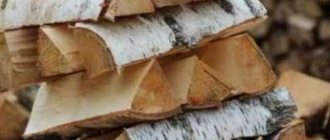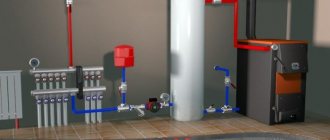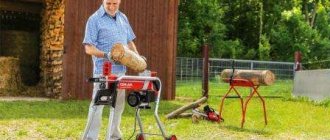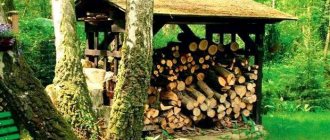Advantages and disadvantages of using it for heating
Positive properties of Euro firewood compared to conventional firewood:
- Scheme of pressing fuel briquettes from soaked paper pulp
High combustion temperature, almost 2 times higher. The heat transfer from wood is about 2500-2700 kcal/kg, and eurowood gives about 4500-4900 kcal/kg. - Low humidity. The smaller it is, the greater the heat transfer rate. For firewood, subject to proper storage, it is in the range of 15-20%, and for briquettes – 4-8%.
- High density - 0.95-1 g/cm3. For example, oak logs with a density of 0.81 g/cm3 burn much hotter than poplar logs with a density of 0.4 g/cm3.
The positive qualities of Eurowood include:
- They don't take up much space.
- They do not harm the environment because they are made from waste.
- They smolder much longer, and most importantly they burn evenly.
- Low soot count and less polluted smoke passage due to dry material.
The disadvantages include:
- Price. Initially, it seems that the cost of briquettes is much higher than firewood. But if you calculate the price per unit of heat that is obtained, the difference will not be so big.
- Instability to moisture. Briquettes require closed storage space with good ventilation, since wet material quickly crumbles.
- Marriage. Unfortunately, there are bad briquettes that are made from soft, rotten, very old, low-quality wood, as well as wood treated with chemicals. They significantly affect the quality of the material.
Alexey, Syktyvkar.
I use two types of boilers for heating:
electric boiler
and solid fuel. Previously, I only used firewood and turned on the electric boiler at night. I bought briquettes because they burn much longer, although they cost twice as much. For heating, two bookmarks are enough: in the morning and in the evening. Saved on electricity.
Valery, Lysva. Because of these briquettes, the kindling stove, which only lasted three years, burned out. It was comfortable to heat a bathhouse with them, but a little expensive.
Timur, Ekaterinburg. I don’t use briquettes all the time, but I started buying them often to make the heating process easier. One package is enough for two bookmarks. I have no idea what the density is, but an ordinary brick stove heats twice as long. The weight of such a brick is greater than that of a log of the same size. As soon as finances allow, I’ll probably switch to them completely.
Lilia, Mirny. From an economic point of view, it is more expedient to use briquettes. Firewood is romantic, but it does create a lot of debris around the fireplace.
Vladimir, Ufa. My house is about 100 m2. Heated by a boiler with an upper load option Karakan 15 kW. I used firewood and also coal, but coal bricks were much better. They burn just like coal, the ash is the same, and most importantly the room is tidy. I like it, I also want to try sawdust, but their price is high.
Andrey, Kaluga region. I use 80 mm peat briquettes of different lengths for a 20 kW Virbel Eco boiler. 25 kg of raw materials is enough for a day for a house of 75 square meters without insulation. The product is super, and the wood looks like a fairy tale. There is little ash compared to firewood. The only negative is the cost.
Kindling the bath
Eurobriquettes are a universal fuel; they can be used to heat all types of stoves and boilers. They can be used in outdoor grills and home fireplaces. At the same time, the consumption of fuel briquettes is always significantly less than conventional firewood.
Many people are interested in whether it is possible to heat a stove with fuel briquettes if it is made of steel, like an ordinary heater? This question is quite logical, since such stoves have restrictions on the calorific value of the fuel; you cannot heat a steel sauna stove with black coal, which emits 4900 kcal/kg of heat. But in the case of Eurobriquettes, less heat is released, which means they can be used to heat a stove in a bathhouse.
For a bathhouse, not only the heat generated is important, but also the duration of burning of wood or alternative fuel. The longer the wood burns with maximum heat release, the better it is for the sauna stove and the sauna itself.
Whole package of fuel briquettes
Lighting fuel briquettes is not very easy, the fire does not catch immediately, but after they light up, they will burn and smolder for a couple of hours, which is much longer than the combustion of ordinary firewood. Such a long combustion time of fuel briquettes is explained by their high density and low humidity.
The large amount of heat generated and the long burnout time indicate that the consumption of fuel briquettes for heating a house is much less than that required for ordinary firewood.
Let us note that, according to people’s reviews, you should not completely fill the firebox of a sauna stove with Euro-wood, so as not to quickly reach the maximum heat transfer values.
An interesting point with Eurobriquettes is the residues left after their combustion. Having increased density characteristics, this fuel burns almost completely; it does not leave a large amount of ash, only a small pile of ash. Ash from fuel blocks smells unpleasant, but is an excellent fertilizer.
Good to know: What equipment is needed for the production of fuel briquettes
When Eurobriquettes burn, virtually no smoke is emitted, which is very valuable for maintaining the cleanliness of fireboxes, boilers, and chimneys. According to experts, linden fuel briquettes contain the least amount of resin, so when using such fuel, chimneys and boiler nozzles suffer the least.
Combustion of Eurobriquettes in the furnace furnace
Fuel briquettes are an excellent option for lighting a black sauna. As we have already said, this fuel is environmentally friendly, does not emit smoke, provides enough heat, and phytoncides appear in the heated air, which have a beneficial effect on the human body and improve immunity. Using the same linden eurobriquettes, you will feel how your body is healing, inhaling the pleasant aromas of flowers, honey and trees.
Of course, there is also a drawback to this type of fuel - it cannot quickly generate a lot of heat, it releases it gradually. As we have already said, the combustion is uniform, which, unlike firewood that flares up quickly and quickly dies out, allows you to easily maintain the same temperature.
Types of briquettes
By material
Alternative fuels are produced from different raw materials, which significantly affects such indicators as:
- Calorie content;
- Ash content indicates the presence of a large number of minerals in the composition that do not burn or have a very low energy value. The greater their number, the lower the heat transfer of the material;
- Soot number;
- Burning rate.
| Material | Ash content, % | Humidity, % | Calorie content, kcal/kg | Density, g/cm3 |
| Straw | 7,3 | 7,8 | 3754-4740 | 1,08 |
| 4,86 | 9,3 | 3742-4097 | – | |
| Seed husk | 3,6 | 2,7 | 4480-5161 | 1,15 |
| 2,92 | 8,51 | – | – | |
| Tyrsa | 0,7 | 7,5 | 4200-4400 | 1,37 |
| Rice husk | 20,2 | 7,1 | 3161-3458 | 1,16 |
| Wood sawdust | 0,8 | 4 | – | – |
| 1,1 | 10,3 | 3985-4341 | – | |
| 1,16 | 4,1 | 4502-5043 | 0,79 |
Type of material and characteristics:
- Husk from seeds. Briquettes have a high calorific value (5151 kcal/kg), as well as a low ash content (2.9-3.6%) due to the presence of oil among the components of the material. It burns well, emits heat well, but significantly pollutes the smoke passage.
- Wood sawdust. Second place in terms of calorific value belongs to European sawdust firewood (4341-5043 kcal/kg). The ash content is exactly the same as when wood is burned (0.5-2.5%).
- Straw. The third place is occupied by straw with a heat transfer of 4740 kcal/kg. The ash content is in the range of 4.8-7.3%.
- Tyrsa. It has good heat transfer (4400 kcal/kg) despite the low ash content (0.7%).
- Rice husk. The ash content is within 20%, as evidenced by the low heat transfer (3458 kcal/kg).
Most often used for the production of briquettes:
- Coal is one of the types of solid fuel of artificial origin, which is created from screenings and corresponding binding components. The material emits about 5000 kcal/kg of heat energy. Advantages of Eurowood:
- safe for the environment;
- easy to transport;
- convenient to store;
- does not emit carbon monoxide;
- Peat is an excellent alternative to wood. Has a high heat transfer rate. It has a long burning period (for example, one load into the boiler can smolder for about 12 hours). Production process. Well-dried, crushed material is heated to a certain temperature and then pressed into small bricks, which are convenient to transport or store. Used for fires and various types of boilers operating on solid fuels. A characteristic feature of peat products is that the resulting ash does not need to be disposed of; it can be used as fertilizer.
- Wood. Euro firewood is created from wood waste, for example:
- not format;
- sawdust;
- dead wood;
- shavings.
Advantages of compressed waste over natural wood:
- The density is the same everywhere, and the structure is uniform (1 m3 contains about 1200 kg of briquettes);
- Higher heat transfer rate (4400 kcal/kg);
- Much lower humidity level (up to 10%);
- A small amount of ash about 1-3%.
- There is no characteristic crackling sound in the boiler;
- Releases less carbon dioxide into the air.
One bookmark maintains the same temperature for approximately 3-4 hours.
Coal briquettes
By shape
Self-production allows you not only to heat the house, but also to save a lot and eliminate long-standing garbage.
Stage 1. Materials for production.
Several raw material options are perfect, for example:
- waste from wood processing;
- paper;
- straw;
- charcoal;
- different types of husk;
- peat.
As binding components can be used:
- clay;
- wallpaper glue or any other inexpensive one;
- paper;
- corrugated cardboard.
Stage 2. Preparation of raw materials. You will need the material itself, as well as additional components: water and clay.
Stage 3. Necessary tools and equipment.
There are enterprises that are engaged in the production and sale of equipment necessary for the production of Euro firewood. For an additional fee, they deliver directly to your home, install it, and also check its functionality. There are companies that teach how to properly operate the devices.
For home production you will need:
- Device for grinding material.
- Drying complex.
- Press. It can be screw, hydraulic or mechanical.
There is no need to use a drying unit, since they can be dried in the open air. If sawdust is used for production, then a grinding device is not required.
In addition, do not forget about a box with cells of the same shape. You can build it yourself from any box, dividing it into the required sectors using planks.
Stage 4. Production. Depending on the material used, we will consider several options for making Euro firewood.
- Step 1. Combine clay with sawdust in a ratio of 1:10. Clay calculation is 100 grams per 1 kg of raw materials. Add a little water and mix thoroughly until the clay covers the sawdust as much as possible. The consistency should be easy to form. To improve the combustion process, you can add well-shredded paper.
- Step 2. Distribute the resulting mixture into molds and compress well. The more liquid you can squeeze out, the better.
- Step 3. Leave the raw material under pressure for a while.
- Step 4. Remove the finished products from the mold and dry them in the firebox or in the sun.
- Step 5. Place the completely dried items in a storage location for future use.
- Step 1. Prepare a large amount of paper and shred it into pieces measuring 2x2 cm.
- Step 2. Fill the paper with warm water and wait until it turns into liquid. Experts advise adding a small amount of starch to water
- Step 3. Eliminate excess water and pour the mixture into molds.
- Step 4. Remove the product from the mold and dry.
Additional heating of the bathhouse and dressing room
If with fuel, in order to get the steam room ready and take a steam bath, everything is clear, then heating the bathhouse in the autumn-winter period is somewhat more complicated. To do this, you should think about how you will carry out heating. Of course, the simplest option is to throw firewood or other selected fuel into the stove and open the door to the dressing room. This will allow it to warm up a bit.
This method requires your constant presence, that is, you need to constantly add firewood to the stove and maintain the temperature, monitor the boiler. To avoid fire, we recommend using electricity or water heating using a double-circuit boiler as permanent heating for the bathhouse. There are options when you can use the boiler both for heating your home and for heating your bathhouse at the same time.
Warm floor in the bath
What to do if the bathhouse is located in the country? An electric heater is not an option, just like water heating. In winter, freezing and rupture of pipes may occur due to a stop in the heating supply. In addition, in winter, the dressing room is quite cold, even if the door to the steam room is often open. But basically, inside the steam room the temperature remains high, and in the waiting room it is quite cold, a strong temperature difference is felt.
We recommend installing heated floors. It will be enough to turn them on 3-4 hours before you are going to relax in the bathhouse or invite guests. This time is enough for the dressing room to warm up well and for the excess moisture to dry out. You can bring an electric heater and thus solve the problem of low temperature and dampness in the dressing room. But most often there is high humidity in this room, which negatively affects the operation of electric heaters and can cause short circuits and breakdowns.
Heating in the bathhouse
Follow the advice, choose the right fuel and follow safety rules. In this case, the stones will be hot for a long time.
Price
| Types of briquettes | Material | Price for 1 ton (rub.) |
| Pini-kay | from pine needles | 8900 |
| birch | 9500 | |
| RUF | from sawdust | 6500 |
| from ancient flour | 7500 | |
| from pine needles | 6000 | |
| from pine and birch | 6500 | |
| birch | 6900 | |
| Nestro | 7500 | |
| Pellets 6-8 mm light | 8800 | |
| Pellets 8 mm gray | 8000 | |
| Peat briquettes | 7000-9000 | |
| Coal | 8000 | |
| Coal briquettes | 9500 |
Blitz tips
- It is best to use wood briquettes made from sawdust, since their quality is as close as possible to firewood. They burn well, have good heat dissipation and a small amount of ash. Euro-firewood made from seed husks is also very good, but they quickly pollute the chimney and heating appliances with soot.
- The heat transfer from hard and coniferous trees is absolutely the same, but pine needles contain resin, which will cause the chimney to become very dirty.
- When buying briquettes, pay attention to the test reports, which indicate the main characteristics of the sample you have chosen.
- Focus on the density of the material; the higher it is, the longer and more evenly the Eurowood will burn. The highest indicator is for Pini-kay, the average is for Nestro, and the lowest is for RUF.
- Before buying a large batch, take several samples in different places and see how they hold their shape and burn. This is the only way to determine their quality.
An alternative solid fuel - briquettes - is an effective and, most importantly, affordable way to heat a house or other outbuildings.
Selecting fuel for kindling
The degree of heating, the microclimate in the steam room and the consumption of firewood depend on the correct choice. Not all wood is suitable for this purpose. This applies to the following categories:
- Old boards or logs. They give off heavy steam and smell bad.
- Rotten raw materials - minimum heat, a lot of waste.
- Painted logs. This is dangerous for the body.
- Knotty firewood is characterized by uneven burning. The wood burns before the knots, and they have to be removed from the stove or chips added.
- Young trees and their branches. They have low heat transfer.
Trees growing near the house are more often used. In steppe areas these are usually branches of bushes. Spruce, pine and birch are taken for kindling in areas where there is forest. Such firewood emits a pleasant aroma of the forest.
The best option for kindling is dry wood with a minimum of knots. Its preparation is carried out in the middle of winter. Frozen logs are easier to split and contain little moisture. Hardwoods are used more often. A hot sauna is obtained using logs made from birch, ash, alder or when using wood from fruit varieties. Coniferous firewood is used less often - the resin contributes to the abundant formation of soot.
Each breed has its own set of characteristics:
- Oak is a prestigious and expensive fuel. Leader in heat transfer if the wood is chosen correctly. Oak logs should be from middle-aged trees. Then the steam will be tart and healing, and the warmth will last for a long time.
- Alder burns quickly, contains almost no resins, so there is no smoke from it. It is distinguished by ardent heat. Its healing aroma invigorates and helps cope with colds. Alder wood dries quickly and can be stored for up to 3 years, while retaining its scent. Destroys soot deposits on the heater.
- Birch – gives a disinfecting heat with light and fragrant steam, beneficial for the respiratory tract. They burn evenly and set quickly. They do not spark, they form a high flame. When birch logs burn, tar and resin are released, which settle on the chimney. This protects the bathhouse from fire, but you have to clean the chimney more often. In terms of heat output they are in second place after oak.
Birch firewood, known for its high heat output, produces an even flame without sparks - Linden burns slowly, but its heat is persistent. Linden steam has a beneficial effect on the lungs if you use firewood that is no more than 2 years old.
- Aspen - gives a little heat and does not light well. Its wood burns quickly, but the flame is long and without soot. When burning, logs help loosen dense soot. There will be more heat if you use other types of firewood at the beginning of the kindling.
- Pine – gives a lot of heat. When kindling, coals “shoot” and a crackling sound is observed. If you heat a sauna with pine logs, the risk of fire increases. The aroma of pine needles, which is released when burning, is beneficial for the respiratory system.
- Poplar sparkles, produces a moderate amount of heat, but burns quickly. It is also not recommended for use in a bath.
- Spruce burns evenly, retains heat for a long time and leaves good coals. It contains a lot of resin, so it produces a characteristic crackling sound and sparks.
- Willow burns well and does not smoke. It burns out quickly, so a large supply of firewood is required.
- Larch - it has little resin, it produces little heat. Produces more carbon monoxide than other rocks. After kindling with larch, it is necessary to ventilate the dressing room and close the damper in time.
Fruit trees are not always available, and it is not profitable to burn poplar trees. It is best to use hardwood logs. Ash, oak, and birch wood are ideal. But the first two varieties are classified as valuable, and they are more often used for furniture production, which is why they are more expensive. Birch is more accessible and practical. It produces almost no soot and produces a lot of heat. The chimney will always be clean if you add aspen firewood at the end of the firebox.
Aspen flares up very slowly and does not burn for long, but it cleans the chimney perfectly, so it is recommended to combine it with other types of logs
Wood pellets are inconvenient to use in a conventional oven. Grate bars with smaller slots or special baskets should be provided for them. Then, when using pellets, the material itself burns first, and then the gases released. Fuel briquettes are much more convenient.
To heat a bathhouse, they will need five times less volume than conventional firewood. But they cost several times more. The heat from briquettes is almost the same, and they burn 25% longer than pure wood. There is a third less ash left after compressed fuel.
The raw material for the production of briquettes and pellets is waste from the woodworking industry. Most often this is dust left over from plywood production. In the process of its creation, phenol and urea are used. When burned, they release substances harmful to health. The smoke from them is corrosive, and there is a lot of soot. If you don’t have firewood on hand or have nowhere to store it, then compressed fuel can be used, but it is not recommended for regular use.
Pellets or fuel granules are made from wood waste and used in pellet stoves
Such materials are absolutely not suitable for sauna stoves. Sleepers most often contain traces of fuel, and due to prolonged contact with the environment, the wood deteriorates and becomes saturated with moisture. The flame from such firewood will be uneven, and they emit little heat and burn out quickly.
Rotten sleepers and painted boards emit an unpleasant odor when burning, as well as toxic substances. Breathing such vapor is harmful to health.
Heating with eurowood
I would like to immediately note that ordinary firewood and modern briquettes are a priori different types of fuel, although their operating principle is identical. (Fuel briquettes are closer in nature to coal.) Ordinary firewood has been used for a very long time, but European firewood still has to prove its worth.
By the way, fuel briquettes received the original name “Eurofirewood” due to their similarity with classic firewood both in shape and technical characteristics.
Modern fuel briquettes are produced from food and natural waste. Wood (sawdust, shavings, wood dust, branches and even leaves), straw remaining after processing grain crops (wheat, rye, corn), husks and husks of seeds, nut shells, peat, and in rare cases even manure are actively used. When burning this kind of material, no harmful substances are released for humans and the environment. No other ingredients are added to fuel briquettes.
Fuel briquettes from various materials
Carefully prepared and crushed raw materials are subjected to temperature pressing, during which excess moisture is removed, the material is held together, and becomes dense and strong. Depending on the type of production, all fuel briquettes can be divided into three classes:
- The simplest one is Ruf fuel briquettes.
- More advanced - Nestro fuel briquettes.
- The most modern are Pini-Kay fuel briquettes.
These types of fuel briquettes differ in shape, final processing method (sometimes there is firing to give the final shape and protection from moisture), level of density, which largely depends on the shape of the briquette itself. The composition of Eurowood always remains the same, without adding third-party elements.
Why is Euro firewood so good? Let’s look at its main advantages:
- Created by pressing at high temperatures, Euro firewood has high density and low humidity. That is why the burning time of fuel briquettes is much longer than that of firewood. The level of heat transfer from briquettes is twice as high, which is explained by the same technical characteristics. Ordinary firewood, dried during the year, has a moisture content of about 20%, fresh wood 40-50%, and for fuel briquettes the same figure is 8-9%.
- Made using professional equipment, having the correct shape and good packaging, fuel briquettes are more compact, convenient and easy to store. At the same time, as we have already said, they burn longer and give off more heat than firewood, which means the fuel supply may be smaller. Heating a house with fuel briquettes in Europe is considered a normal practice, moderately economical. In Russia, wood is traditionally used.
Fuel briquettes of the correct shape
- Using fuel briquettes is extremely simple; the technology for burning them is no different from ordinary firewood. You could even say that they are safer to use since the level of fire and its operation can be controlled.
- When storing firewood in the house there is always a lot of garbage, but the briquettes are tightly packed in cellophane and loaded into the oven entirely.
- Eurowood burns with a stable fire, it does not spark or smoke, and the amount of smoke emitted can be called minimal. By loading briquettes into the oven in various ways, you can regulate the intensity of fuel combustion. A small amount of smoke allows you to save on cleaning the chimney from soot, and also allows the use of such fuel in black baths.
- After using fuel briquettes, very little ash remains, approximately 1% of the total volume of fuel. Unlike firewood, briquettes burn almost completely.
- With proper skill and suitable equipment, you can make fuel briquettes with your own hands. At first glance, the task seems impossible, but upon detailed analysis everything turns out to be very simple. In the future, such production will help significantly save the budget on fuel.
Simple cellophane packaging for fuel briquettes
Having considered the advantages of fuel briquettes, we move on to the disadvantages that also exist:
- Having a high density, European firewood takes a long time to burn in the firebox. When studying whether it is better to heat a stove, with wood or briquettes, you should definitely pay attention to this. You can't start a fire quickly with alternative fuels; you need the right materials. Even a good, dense, dry briquette takes a few minutes to warm up.
- When burning briquettes of some types, characteristic odors may be present. For example, the aroma of burning seed husks may not be to everyone's taste. The ash from Eurobriquettes smells absolutely disgusting, but despite this it is an excellent fertilizer.
- Fuel briquettes are afraid of dampness, even if they are burned on the outside. A product packed in cellophane is not afraid of moisture, but after being removed from a vacuum package, the briquette becomes vulnerable. Due to humidity, Euro firewood crumbles and becomes unsuitable for use.
- Mechanical impacts for Eurobriquettes are also unacceptable. Even when dry, you can break them, especially if they are of poor quality.
- Fuel briquettes are not capable of creating a unique atmosphere of warmth, comfort and coziness that is inherent in firewood. They do not crackle, the fire from them is too simple, smoldering, and the appearance leaves much to be desired, especially homemade options. From an aesthetic point of view, fuel briquettes are not suitable for use in a fireplace.
Burning briquettes in the furnace firebox
When choosing firewood or briquettes for heating your home, you should also analyze ordinary wood, at least for its merits.
Good to know: Manufacturers of fuel briquettes, what types of products they make
How to light a stove in a bathhouse
It all starts with the preparatory stage. He is the most labor intensive of all. Before starting work, it is advisable to find out how to heat a bathhouse if you have no experience in this matter. Firewood is prepared in advance. Dry logs are carefully placed in an accessible area, but not too close to the fuel door, so as not to provoke their spontaneous combustion.
It needs to be put in order - open the stove, clean the ashpit, remove all the ash and coals from the combustion chamber. This waste does not need to be thrown away - it makes good fertilizer.
If the stove structure is equipped with a water tank, you should make sure that water is present there. Then the draft in the chimney is checked. All doors and dampers open. Next, a match or splinter is lit and placed in the combustion chamber. If the flame flutters and moves upward, then the draft is fine.
In its absence, it is dangerous to start kindling. All the smoke will go into the room, and then you can suffer from carbon monoxide.
First, the seed is made. Tree bark or crumpled newspaper is placed on the grates in the stove opening. Wood chips and finely chopped logs are placed on top. Gaps must be left between them so as not to interfere with the free circulation of air. Do not use gasoline for ignition. This is fraught with the risk of a fire, and the released steam will lose its healing properties due to the presence of chemicals in it.
First of all, wood bark or paper is placed in the oven, and only wood chips are placed on top
The order of kindling is as follows:
- We ignite the seed from below. We close the firebox door so that no smoke comes into the dressing room and the flame flares up well.
- If a steady sound comes from there, there is combustion. If it is absent, the procedure is repeated again.
- You need to close the ashpit and open the valve.
- Firewood is added at intervals of 5-15 minutes. It all depends on the degree of dryness and heating of the stove.
- After the first batch has burned out, the firebox door is opened, the coals are leveled with a poker and logs are laid.
- Firewood must be placed so that the distance between it and the top of the firebox is at least 25 cm. Fuel is placed closer to the door, away from the chimney.
- During the combustion process, you need to monitor the water level in the boiler and add it as needed.
To heat the sauna faster, it is not advisable to water the heater during the heating process. It is better to wait until the bath procedures begin.
How much to heat?
Certain factors indicate the readiness of the bath:
- The temperature in the steam room is not lower than 60 C⁰;
- In the boiler, the water reaches its boiling point;
- The last portion of firewood burned down to red coals;
- The stones were well heated.
For the convenience of determining the temperature in the steam room, it is recommended to use special bath thermometers
In winter, this takes 5-6 hours, and in the warm season, 3-4 hours is enough. As soon as the required temperature is established in the bath, the firebox can be finished. If there are no blue flames above the coals, which is considered a sign of the presence of carbon monoxide, the vent, firebox and smoke damper are completely closed.
The sauna stove, made of red brick, heats up quickly and does not cool down for a long time. Due to this, a high temperature is maintained in the steam room even after the end of the fire, if the chimney was closed in time. The algorithm for kindling and adding firewood remains unchanged, the only difference is that firewood can be placed in a large volume in a brick stove.
A few large stacks of logs are enough to bring the room to operating temperature. Therefore, when lighting a brick stove, it is better to use wood with good heat transfer - oak, birch or ash. They are laid so that there are small gaps for air between them. If you do this closely, the flame may go out. After 1-2 hours you can go to the steam room.
Are briquettes suitable for saunas or are they only used for heating a home?
Briquettes are made in special presses by burning and sintering sawdust with a gas-air mixture and further pressing under high pressure. The density of briquettes is three or four times higher than that of the best firewood. The briquette contains much more wood than the tree itself, no matter how strange it may sound.
Fuel briquettes are very versatile and are suitable for all types of stoves and boilers . They are even suitable for barbecues, fireplaces or large industrial boilers. Yes, manufacturers of steel sauna stoves made of steel, so-called heaters, do not recommend using fuel with a calorific value higher than 4900 kcal, and black coal has this value. But that’s the beauty of briquettes, that their calorific value is slightly lower, so even the most “delicate” stoves will digest them perfectly. But we are talking about the firebox of a bathhouse, and here the most important thing is the length of burning or smoldering. In other words, what is important to us is not the speed of heating the room (although briquettes are fine with this), but that the fuel generates heat for as long .
Due to low humidity and high density , fuel briquettes burn and then smolder for a very long time, at least two hours. According to this indicator, they at least twice as good as firewood This means that less European firewood will be required to heat the sauna and maintain heat in the firebox. The firebox can not be filled to its full depth, but only halfway. What else is important for a bath? What is important is the environmental friendliness of the fuel, with which everything is in order. Firstly, briquettes have an ultra-low ash content, it does not exceed 0.8-0.9%. Therefore, after burning a briquette, what remains in the firebox is not a huge pile of ash, but only a small pile of ash, which can be easily removed. Secondly, briquettes emit much less smoke, thereby keeping boilers, fireboxes and chimneys clean for much longer. Linden briquettes are especially good , which is exactly what our company produces. Of all types of wood, linden contains the least amount of resin , so fuel briquettes made from this tree do not pollute fuel systems and chimneys at all. Moreover, the use of linden fuel briquettes reduces the risk of corrosion and contamination of boiler nozzles.
With fuel briquettes, the black sauna opens up in a completely new way. There is minimal smoke and no suffocating tars either. What is there? And there are many phytoncides that heal the body and strengthen the immune system. This is especially noticeable when burning with linden fuel briquettes. The entire bathhouse is filled with the enchanting aromas of flowers and honey, the smells of meadows and fields - just an incredible atmosphere.
Well, a few words about storage. We all know very well what a hassle it is: delivering, unloading and preparing firewood for use. Often you have to work hard with an ax, after which wood chips, bark and other waste remain, spoiling the appearance of the area or bathhouse. With briquettes you are free of such problems, since they are supplied in packs of 10-12 bricks each. The packs are wrapped in a thick film that protects the briquettes from moisture and other aggressive influences. Since briquettes are shaped like bricks, they are very easy to stack, and you can even build entire walls from briquettes. They take up very little space in the bathhouse, look organic and even stylish. And we’re not even talking about ease of storage and use - it’s clear without words.
To summarize: fuel briquettes are an excellent alternative to firewood . An alternative that will save the family budget , save equipment, free up and improve more space. And most importantly, it will help you experience even more pleasure from bathing!
Source
